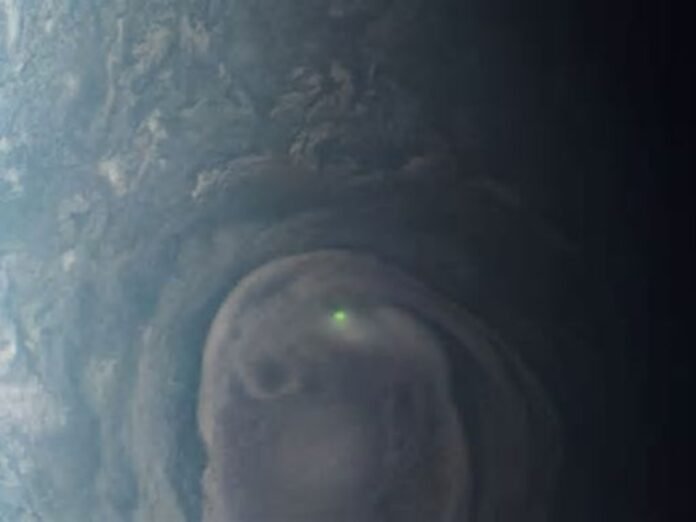Introduction:
The enigmatic wonders of space continue to captivate our imagination, with NASA’s James Webb Space Telescope unveiling stunning images that push the boundaries of our understanding. Adding to the intrigue, NASA’s Juno spacecraft, currently orbiting Jupiter, recently captured a mesmerizing image revealing a green orb deep within the planet. While speculation about extraterrestrial signals arose, NASA has clarified that the image actually depicts the glow from a lightning bolt on Jupiter.
Unraveling the Phenomenon:
A NASA blog post elucidated the phenomenon, explaining that the image portrays a vortex near Jupiter’s north pole, with Juno capturing the radiant glow of a lightning bolt. On Earth, lightning typically originates from water clouds and is most commonly observed near the equator. Conversely, on Jupiter, lightning is likely to occur within clouds containing an ammonia-water solution and is frequently observed near the poles.
The Image and Juno’s Mission:
The image was not a recent snapshot by Juno but was taken on December 30, 2020, during the spacecraft’s 31st close flyby of Jupiter. Kevin M. Gill, a citizen scientist, processed the raw data from JunoCam, a visible light telescope camera onboard Juno, to create the image. Juno was approximately 32,000 kilometers above Jupiter’s cloud tops when the image was captured.
The JunoCam’s primary purpose is to study the dynamics of Jupiter’s clouds, particularly those at the poles. Initially expected to operate for the first eight orbits or until September 2017, the JunoCam has exceeded expectations and remains functional. In the coming months, as Juno continues its orbits, the spacecraft will pass over Jupiter’s night side multiple times, offering further opportunities for the suite of science instruments onboard Juno to observe and study lightning activity.
Juno’s Mission Objectives:
NASA’s Juno Mission aims to gather crucial data about Jupiter’s composition, gravitational field, magnetic field, and polar magnetosphere. Additionally, scientists hope to uncover insights into the planet’s origin, the existence of a rocky core, the amount of water within the deep atmosphere, mass distribution, and the powerful winds that can reach speeds of up to 620 kilometers per hour.
Conclusion:
The captivating image captured by NASA’s Juno spacecraft, revealing the mesmerizing glow of a lightning strike on Jupiter, serves as a reminder of the mysteries that await us in the vastness of space. Juno’s ongoing mission to study Jupiter’s composition and atmospheric dynamics has already provided valuable insights, and with continued observations of lightning activity, we can expect further revelations about this awe-inspiring gas giant. As our exploration of the solar system progresses, each new discovery brings us closer to unraveling the secrets of our celestial neighbors.




